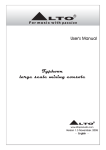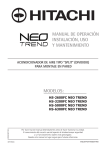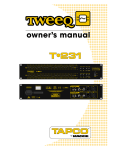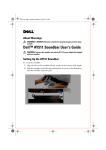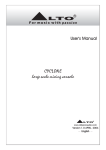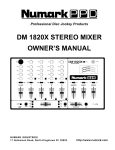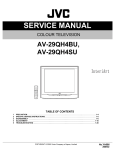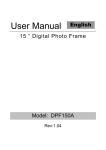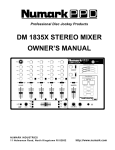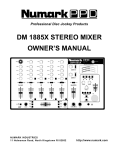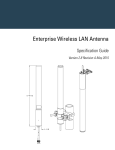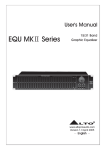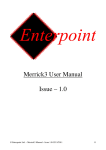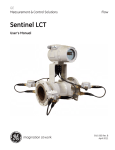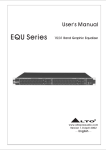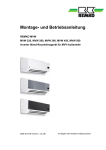Download LTO Typhoon large scale mixing console
Transcript
R LTO For music with passion User's Manual Typhoon large scale mixing console R www.altoproaudio.com Version 1.3 November. 2005 English Fuse SAFETY RELATED SYMBOLS To prevent fire and damage to the product, use only the recommended fuse type as indicated in this manual. Do not short-circuit the fuse holder. Before replacing the fuse, make sure that the product is OFF and disconnected from the AC outlet. CAUTION RISK OF ELECTRIC SHOCK DO NOT OPEN This symbol, wherever used, alerts you to the presence of un-insulated and dangerous voltages within the product enclosure. These are voltages that may be sufficient to constitute the risk of electric shock or death. Protective Ground Before turning the product ON, make sure that it is connected to Ground. This is to prevent the risk of electric shock. This symbol, wherever used, alerts you to important operating and maintenance instructions. Please read. Never cut internal or external Ground wires. Likewise, never remove Ground wiring from the Protective Ground Terminal. Protective Ground Terminal Operating Conditions AC mains (Alternating Current) Always install in accordance with the manufacturer's instructions. Hazardous Live Terminal ON: To avoid the risk of electric shock and damage, do not subject this product to any liquid/rain or moisture. Do not use this product when in close proximity to water. Denotes the product is turned on. OFF: Denotes the product is turned off. WARNING Do not install this product near any direct heat source. Describes precautions that should be observed to prevent the possibility of death or injury to the user. Do not block areas of ventilation. Failure to do so could result in fire. CAUTION Keep product away from naked flames. Describes precautions that should be observed to prevent damage to the product. IMPORTANT SAFETY INSTRUCTIONS Read these instructions Disposing of this product should not be placed in municipal waste and should be Separate collection. Follow all instructions Keep these instructions. Do not discard. Heed all warnings. WARNING Only use attachments/accessories specified by the manufacturer. Power Supply Ensure that the mains source voltage (AC outlet) matches the voltage rating of the product. Failure to do so could result in damage to the product and possibly the user. Power Cord and Plug Do not tamper with the power cord or plug. These are designed for your safety. Unplug the product before electrical storms occur and when unused for long periods of time to reduce the risk of electric shock or fire. Do not remove Ground connections! External Connection Protect the power cord and plug from any physical stress to avoid risk of electric shock. If the plug does not fit your AC outlet seek advice from a qualified electrician. Always use proper ready-made insulated mains cabling (power cord). Failure to do so could result in shock/death or fire. If in doubt, seek advice from a registered electrician. Do not place heavy objects on the power cord. This could cause electric shock or fire. Cleaning When required, either blow off dust from the product or use a dry cloth. Do Not Remove Any Covers Within the product are areas where high voltages may present. To reduce the risk of electric shock do not remove any covers unless the AC mains power cord is removed. Do not use any solvents such as Benzol or Alcohol. For safety, keep product clean and free from dust. Servicing Covers should be removed by qualified service personnel only. No user serviceable parts inside. Refer all servicing to qualified service personnel only. Do not perform any servicing other than those instructions contained within the User's Manual. 1 PREFACE Dear Customer: Thank you for choosing the For LTO TYPHOON which is the result of our LTO AUDIO TEAM's endeavours. LTO AUDIO TEAM music and audio are much more than a job, they are a passion and an obsession! We have, in fact, been designing professional audio products for a number of years in cooperation with many of the world's major brands. The LTO line represents unparalleled analogue and digital products made by musicians, for musicians. With our design centres in Italy, the Netherlands, and the United Kingdom we provide you with world-class designs, while our software development teams continue to develop an impressive range of audio specific algorithms. By purchasing our LTO products you become the most important member of our LTO AUDIO TEAM. We would like to share with you our passion for what we design and we invite you to make suggestions, which will aid us in developing future products for you. We guarantee you our commitment to quality, continual research and development, and of course the best performance/price ratio. The LTO TYPHOON is a large format versatile 8-bus sound reinforcement mixing console designed for all types of live sound production as well as for recording purposes. Each channel is equipped with a variety of key features including a warm, natural sounding four band sweep EQ (4 band fixed EQ for stereo channels), 8 Auxiliary sends, Clip preamp and fader LEDs etc.. Besides, the TYPHOON is equipped with fully featured intercom and talkback sections that will allow the sound engineer to work in a very fast and reliable way. Seeing is believing, let's meet LTO TYPHOON. We would like to thank all the people that worked with us to make a vision real! Our designers and LTO staff made the LTO TYPHOON, large format 8-bus sound reinforcement mixing console, a very reliable and high quality product ready for all your venues. And thanks to their passion for music and professional audio it has been possible for us to offer you, our most important team member, our continued support too. Thank you very much LTO AUDIO TEAM 2 TABLE OF CONTENTS SAFETY INSTRUCTIONS ..........................................................................................................................1 PREFACE ...................................................................................................................................................2 TABLE OF CONTENTS .............................................................................................................................3 INTRODUCTION ........................................................................................................................................4 MAIN FEATURES ......................................................................................................................................5 INSTALLATION AND CONNECTIONS ..................................................................................................6-7 TYPHOON PICTURES ...........................................................................................................................8-9 FUNCTIONAL DESCRIPTION ............................................................................................................10-31 Typhoon Mono input channels .............................................................................................................10-14 Typhoon Stereo input channels ...........................................................................................................15-19 Typhoon Master Section ......................................................................................................................20-27 TYPHOON CONNECTIONS WIRING .................................................................................................28-31 GLOSSARY ..............................................................................................................................................38 TECHNIQUE & TROUBLESHOOTING ..............................................................................................32-37 BLOCK DIAGRAMS ...............................................................................................................................39 TECHNICAL SPECIFICATIONS .........................................................................................................40-41 EXTRA PAGE ......................................................................................................................................42-51 WARRANTY .............................................................................................................................................52 3 INTRODUCTION Our current top mixer line...fitted with a wide range of controls to satisfy the needs of the most demanding professional with its real hi-fi specs and its user-friendly and ergonomic design despite the very high quantity of controls! These models are ideal for large venue and large bands. Thank you very much for expressing your confidence in LTO products by purchasing LTO's first large format mixing console Typhoon, an 8-bus sound reinforcement mixing console designed for all types of live sound production. We're proud to introduce you our first large format mixing console, designed and developed to meet the needs of the demanding live sound engineers, providing the quality, all the features and the reliability you deserve, with its real hi-fi specs and its user-friendly and ergonomic design despite the very high quantity of controls! The Typhoon is an all purpose FOH mixing console that can be used as Monitor mixer as well, thanks to its 8 independent auxiliary sends. Each mono channel offers microphone and line input, direct out and insert points, lo-cut filter, four band sweep EQ. etc. The stereo channel offers stereo (left & right) line input with four band fixed EQ, as well as mono input with discrete mic &line connections and lo-cut filter. Following the needs of professional live sound engineers we included a lot of special features, like a Talkback section and a 3-frequency Oscillator, and double CLIP indicator to immediately understand at a glance the behaviour of every channel mono signal. The Typhoon is a large format professional mixing console. You will get a smooth, accurate more natural and open sound from this tool, it is really ideal for gigs, recording and fixed PA installations. Your Typhoon has been designed to be a very versatile and user-friendly mixing console, so it's very easy to operate but we advise you to go through each section of this manual carefully. In this way you will get the best out of your Typhoon in all application. 4 MAIN FEATURES Pre-insert preamp CLIP LED Extremely high headroom offering excellent dynamic range Post-fader, post-EQ Direct output, can become pre-fader post-EQ by an internal jumper Pre-fader, pre-eq channel insert MIC input channels with golden plated XLRs and balanced LINE inputs 4-band sweep EQ on mono channels 4 Stereo input channels with left-right balanced TRS jacks, and mono MIC & line inputs 4-band fixed EQ on stereo channels Ultra-low noise discrete Mic Preamps with +48V Phantom Power 100mm high precision faders Each input channel features Mute & SOLO switches, Overload & signal present LEDs and low cut filters (except stereo line inputs) Fader CLIP LED SUB 1-2, 3-4, 5-6, 7-8 & MAIN L-R signal assignment switch 8 AUX sends with pre-post-fader assign switches Channel inserts and direct outputs on each mono channel for connection of outboard equipment Groups, Aux sends and Main Mix inserts for flexible connection of outboard equipment Control room/phones discrete level Fully assignable Oscillator and Talkback sections Three-frequency, three-level oscillator XLR socket for lighting lamps 2-TRACK IN path Highly accurate 16 segment output level meters 5 INSTALLATION AND CONNECTIONS [ INSTALLATION ] The following counsels must be observed to maintain safety and electromagnetic compatibility performance in order to obtain the best possible performances by your Typhoon. Earthing & Power Connections Since all the signals are referenced to earthing system, it's very important that it's clean and noise free. The best way to do an earthing system is to use a "star fed" instead of "daisy chain". A "star fed" earth connection means that independent wires runs for each outlet, in this way you'll provide a safety reference screen for each single equipment. Never mix the mains audio earthing outlets with light earthing outlets, it could very easily generate interferences and audio degradation. Please try to avoid placing the console close/on any power distribution units or power amplifiers. When using an external power supply, it should be located as far as possible from the console. The power supply should be set for the voltage supply available in your area and plugged into the mains socket using the cable provided with the ground/screen connector properly connected. The Typhoon should only be operated with the power supply connected to ground via the ground in the mains connector. The use of alternative power supplies may cause damage and void the warranty. The power supply should never be operated with the mains earth disconnected Please note that the power supply contains DANGEROUS VOLTAGES, much stronger than the mains voltage. The power supply rails can produce extremely large currents which could burn out equipment and wiring if shorted. Electric & Magnetic Fields When the console is operated close to an electromagnetic field (generated by video monitors, high-power electric cabling, etc.), you should detect an audio degradation induced by voltage picked up by leads and chassis. In this case the signal to noise ratio may be degraded, under extreme conditions (3V/m, 90% modulation) degradation of up to 40dB may be experienced. Wiring To ensure the correct and reliable operation of your Typhoon mixing console, only high quality screened twisted pair audio cable and metal bodied connectors should be used. Position Place the mixing console on a flat and even surface, avoiding extremely hot, cold, dust or humid places. Your Typhoon should be situated so that its location or position does not interfere with its proper ventilation (e.g. on a carpet, on felt, etc.). When positioning the console for front of house usage it is worth placing the console in the "sweet spot" position (where the sound system used can be properly heard from the mix position). Try to avoid placing the console behind pillars or large objects , or mixing from a level above the speaker position (e.g. from a balcony). WARNING: Always switch off the power supply off before connecting or disconnecting the mixer power cable, removing or installing modules, and servicing. In the event of an electric storm or large mains voltage fluctuations, immediately switch off your Typhoon and disconnect the mains plug from its socket. WARNING: Do not replace the fuse with any other type, or short-circuit the broken fuse, this could become a safety hazard and will void the warranty. WARNING: All servicing should ONLY be carried out by skilled personnel of an authorized maintenance centre. 6 [ CONNECTIONS ] All connector shells should be of metal construction in order to provide a screen when connected to the console. The Typhoon deserves to be operated with high quality twisted-pair audio cables to develop its full audio performances. XLR plug & socket Pin 1 - Screen/Ground Pin 2 - Hot Signal Pin 3 - Cold Signal 6,3mm. (1/4") Jack - BALANCED connections TRS signal Sleeve Screen/Ground Ring Cold signal Tip Hot signal 6,3mm. (1/4") Jack - unbalanced connections TS signal Sleeve Screen/Ground Tip Signal 6,3mm. (1/4") TRS insert Sleeve Screen/Ground Ring Insert return Tip Insert send 6,3mm. (1/4") TRS headphone Sleeve Screen/Ground Ring Right signal Tip Left signal Owner's manual conventions Writing this owner's manual we used the following conventions: 1. The names of the keys switches and connectors used in this owner's manual match the labels on the unit Examples: MIC IN -> Microphone input MID-H -> Mid-High frequency boost/cut control GR1-GR2 -> Group 1 & Group 2 2. The condition of the indicators on your mixer is surrounded by " ", e.g. "light" or "flash". 7 TYPHOON PICTURES TYPHOON 1600 TYPHOON 2400 8 TYPHOON PICTURES TYPHOON 3200 TYPHOON 4800 9 FUNCTIONAL DESCRIPTION [ Typhoon Mono Input Channels ] The Typhoon is supplied with all the connections pro users deserve to connect every kind of signal sources to Typhoon inputs. Direct Out This unbalanced connector can be used to directly output the signal of the channel for recording & other purposes. This output can be set pre- or postfader by an internal jumper. Please note that the Mute switch of the channel affects this connector when set to post fader. The wiring is Tip = Hot Ring & Sleeve = Screen. DIRECT OUT MIC IN Insert INSERT LINE IN LINE IN INSERT This unbalanced 1/4" jack connector has been designed to be used as insert point, breaking the signal path immediately after the preamp section and before the EQ section to allow the pro user to insert a dynamic compressor, a parametric EQ, as well as other ancillary equipment. Please note that the Mute switch of the channel does not affect this connector. The wiring is Tip = Insert Send, Ring = Insert Return, Sleeve = Screen. DIRECT OUT Line in MIC IN CH 2 CH 1 This balanced input connector has been designed to accept line inputs up to +22dBu. You can connect here keyboards outputs, mixer outputs, tape outputs, etc. The wiring is Tip = Hot, Ring = Cold, Sleeve = Screen. MICROPHONE in This XLR socket has been designed to accept microphone signals up to +22dBu, providing phantom power for condenser microphone when the switch in the front panel is engaged. Pin1 = Screen/Ground, Pin2 = Hot Signal, Pin3 = Cold Signal. 10 [ Typhoon Mono Input Channels ] We perfectly know the importance of the preamp section, a good preamp section will allow the sound engineer to work with maximum dynamics, an exceptional signal-to-noise ratio... then to be able to use EQ, external dynamic controls and other ancillary equipment to shape its own sound! The Typhoon preamp section features all the useful controls to accurately manage the sound source in the most versatile way. PHANTOM POWER switch & LED PHASE switch & LED The switch must be engaged when you're using a condenser microphone or a direct box that can be powered by phantom power, instead of batteries. The LED gives the user a visual control over channels with phantom power on. This switch allows the user to invert by 180 the signal. This switch is very useful in a lot of circumstances, in particular when several microphones are very close (e.g. drum kit, brasses, chorus, etc.) and the sound engineers notices interferences between microphones that can not be solved moving the microphones. The LED gives an immediate control over channels with inverted phase electronic circuits. PHANTOM 48V ON OFF PHASE OUT IN CLIP GAIN GAIN The GAIN control gives you the chance to continuously adjust the pre-amplifier gain for input signal. This control can be adjusted in 0/+60dB range for microphone input and -25/+35dB for line input. +60 +35 0 -25 125 HIGH PASS freq Hz 40 400 ON OFF CLIP LED At LTO we're very careful about the feedback we continuously receive by our customers and the demands of pro users. For this reason we included a preamp CLIP LED, allowing the sound engineer to detect the clip incurring at the beginning of the audio path. The preamp CLIP LED turns on when the input level reaches 6dB before clipping. If the clipping has been generated by other channel controls (e.g. an excessive boost by EQ.) the sound engineer will see the preamp CLIP LED not lighted, while the fader clip LED will be lighted. In this case the research of the fault will become much faster! HIGH PASS LED A very useful LED shows if the HIGH PASS section is active or not. HIGH PASS switch This section allow the sound engineer to reduce the lower frequencies by engaging the switch and selecting the turnover frequency in 40Hz/400Hz range. This control is very useful when you detect hum or rumble or you want to cut unwanted low frequency sounds picked-up by microphones. 11 [ Typhoon Mono Input Channels ] We provided a very versatile EQ circuit with four sweep filters to satisfy professional users demand. Thanks to the wide overlap section of the 4 filters, this EQ allows to shape in a very efficient way the sound of all the sound sources the sound engineers has to manage. HIGH gain HIGH freq 0dB It's a shelving filter giving the user a continuous adjustment of boost and cut from +15dB to -15dB. HIGH -15 4 +15 HIGH freq KHz It's a peak/dip filter giving the user a continuous adjustment of boost and cut from +15dB to -15dB. 1.6 0dB 16 MID-H -15 3.2 EQ MID-H gain +15 MID-H freq KHz MID-L gain .8 0dB 8 MID-L It's a peak/dip filter giving the user a continuous adjustment of boost and cut from +15dB to -15dB. -15 640 +15 MID-L freq Hz LOW gain It's a shelving filter giving the user a continuous adjustment of boost and cut from +15dB to -15dB. EQ LED This useful LED will allow the sound engineer to immediately understand if the channel has been equalised or not. 160 0dB It's the control to set the centre frequency of the HIGH control. It can be adjusted in 1,6-16kHz range. It affects the frequency area from the upper fundamental frequencies up to the higher harmonic frequencies, allowing the skilled user to add brightness to sound sources as well as reduce unwanted hiss and high frequency noises. MID-H freq It's the control to set the centre frequency of the MID-H control. It can be adjusted in 0.8-8kHz range. It affects the frequency area from the upper fundamental frequencies up to the higher harmonic frequencies, allowing the skilled user to add or to subtract brightness to sound sources to avoid masking frequencies effects. 1.6K LOW MID-L freq -15 160 +15 LOW freq Hz 40 ON OFF 400 EQ It's the control to set the centre frequency of the MID-L control. It can be adjusted in 0.16-1.6kHz range. It affects the frequency area of most of fundamental tone frequencies up to lower harmonic frequencies, allowing the skilled user to add/ subtract impact and/or presence to sound sources giving them a particular sound character. LOW freq It's the control to set the centre frequency of the LOW control. It can be adjusted in 40-400Hz range. It affects the frequency area from the lower fundamental frequencies, allowing the skilled user to add "boominess" to sound sources as well as to reduce unwanted hum and rumble noises. EQ switch This switch allows the user to use the EQ. Section in signal path. Of course it can be used too to make A/B comparisons between equalized signal and not equalized signal to control the . It can be used too to apply equalization at a certain point of the show, excluding it when it's not necessary. 12 [ Typhoon Mono Input Channels ] At LTO we thought that you deserve a very versatile auxiliary section. So we provided you eight discrete auxiliary sends with independent level controls and several pre-/post-fader switches. Generally pre-fader is used for monitor purposes, allowing the sound engineer to set a level that's independent by channel fader setting. In this way the control will be much more accurate and the sound engineer doesn't risk unwanted feedback when, for example, he raises the level of the lead singer. Post-fader sends are better suited for FX sends control. By doing so, for example, the sound engineer will raise the fader level of the lead singer the effect send as well, maintaining the same sound balance between "dry" & "wet" signals. Please note that the channel Mute switch affects these controls. 0dB AUX 1 - +10 8 The AUX 1 send level can be adjusted from up to +10dB. AUX1 PRE 0dB +10 8 The AUX 2 send level can be adjusted from up to +10dB. 0dB This switch sets pre-/post-fader the Aux 1 signal. AUX2 PRE AUX 2 - POST PRE/POST switch POST PRE/POST switch This switch sets pre-/post-fader the Aux 2 signal. AUX3 PRE 0dB AUX 3 & 4 AUX4 POST - 0dB PRE/POST switch Auxiliary sends 3 & 4 share the same pre-/ post-fader switch. +10 8 The AUX 3 & 4 send level can be individually adjusted from - up to +10dB. +10 8 - AUX5 PRE/POST switch - +10 8 AUX 5-8 0dB Auxiliary sends 5 to 8 share the same pre-/ post-fader switch. AUX6 PRE +10 8 - 0dB AUX7 POST +10 8 - 0dB - 8 The AUX sends 5 to 8 level can be individually adjusted from - up to +10dB. AUX8 +10 13 [ Typhoon Mono Input Channels ] The assign section is useful to manage the output assignment to several outputs, as well as direct out, to listen "in solo" a channel and to mute or not a channel signal. OUTPUT Assign 1/2 3/4 5/6 7/8 L/R These switches allow the sound engineer to address the signal to selected audio path. The odd/even numbered switches are used to send the signal to sub-groups while L/R switch sends the signal directly to Main Mix output. Please check the "technique & troubleshooting" section of this owner's manual for further details about the way to use those switches. M1, M2, M3 & M4 GR1-GR2 M1 GR3-GR4 M2 GR5-GR6 M3 GR7-GR8 M4 MUTE L/R centre Left PAN Right These switches are very useful to manage the sound in a fast and reliable way. You can use M1, M2, M3 and M4 to program four MUTE memories. This feature is important to give an immediate control over some channels that are not used all show long (e.g. some instruments played just in some songs, the voice of the presenter, etc.) and to immediately recall al the mixers status. See section 7 of this owner's manual for the procedure to store and recall the four Mute Groups memories. CLIP PAN This pot allows the sound engineer to place the channel signal in a stereo front from hard left to hard right. Of course you can use it also to "move" the channel signal in stereo front to create spatial effects. MUTE -20 -20 & CLIP LEDs These LEDs are very useful to control the behaviour of the channel signal path after the insert point, the EQ section and the fader. So you could notice the fader CLIP LED turned on while the preamp CLIP is not lit, or vice-versa. In both cases the presence of two CLIP LEDs will help the sound engineer to immediately detect where is the problem. 10 5 0 MUTE You can use the MUTE switch to mute the channel signal when you don't need its sound. When this large switch is engaged, it's lit. The signal is still sent only to insert point, while the direct out is muted too. 5 10 PFL/Solo switch 20 30 Fader This long coarse fader will give to the sound engineer the ability to accurately manage the channel output level from - up to +10dB. 8 40 50 60 - PFL/SOLO ON OFF CH 1 14 This switch allows the sound engineer to control the channel signal. The PFL (pre-fade listen) signal is pre-fader and mono while Solo stands for SIP (Solo In Place), the signal is post-fader, placed in stereo front and it "opens" all the circuits of related effect. When this large switch is engaged, it's illuminated to give you an immediate visual control of which, and how many channels are in solo. When the MASTER SOLO switch is engaged this switch acts in SOLO mode and mutes all other channels [ Typhoon Stereo Input Channels ] Each Typhoon is supplied with four stereo input channels. These channels are ideal for stereo signals but we included the same circuit of mono inputs, with discrete preamp level section and low-cut filter. So the sound engineer has the choice to use a mono signal and a stereo signal outputs in the same channel in different times without being obliged to change the GAIN control! RIGHT This balanced input connector has been designed to accept line inputs up to +22dB. This connector should be only used for the right output of an instrument. The wiring is Tip = Hot, Ring = Cold, Sleeve = Screen. RIGHT LEFT (MONO) MIC IN LINE IN LEFT (MONO) LINE IN LEFT (MONO) This balanced input connector has been designed to accept line inputs up to +22dB. This connector should be used for the left or mono output of an instrument. This input follows the stereo path. The wiring is Tip = Hot, Ring = Cold, Sleeve = Screen. Line in RIGHT MIC IN CH 43/44 CH 41/42 This balanced input connector has been designed to accept line inputs up to +22dB. You can connect here keyboards outputs, mixer outputs, tape outputs, etc. The wiring is Tip = Hot, Ring = Cold, Sleeve = Screen MICROPHONE in This XLR socket has been designed to accept microphone signals up to +22dB, providing phantom power for condenser microphone when the switch in the front panel is engaged. Pin1 = Screen/ Ground, Pin2 = Hot Signal, Pin3 = Cold Signal. 15 [ Typhoon Stereo Input Channels ] The Typhoon preamp section is fully featured with all the useful controls to manage the sound source. There are two different preamp input path for mono or stereo signals, the latter features just GAIN while the mono preamp input is regularly featured like any other mono input. In this way the sound engineer can use, for example, the stereo keyboard outputs in the same channel of the entertainer voice, if both signals are not required at the same time and each source will has its own level control. PHANTOM POWER switch & LED The switch must be engaged when you're using a condenser microphone or a direct box that can be powered by phantom power, instead of batteries. The LED gives the user a visual control over channels with phantom power on. PHASE switch & LED PHANTOM 48V ON OFF PHASE OUT IN CLIP MONO IN GAIN 0 +60 125 HIGH PASS GAIN The GAIN control gives you the chance to continuously adjust the pre-amplifier gain for input signal. This control can be adjusted in 0/+60dB range for microphone input/ line input. freq Hz 40 This switch allows the user to invert by 180 the signal. This switch is very useful in a lot of circumstances, in particular when several microphones are very close (e.g. drum kit, brass, choirs etc.) and the sound engineer notices interferences between microphones that can't be by solved moving the microphones. The LED gives an immediate control over channels with inverted phase electronic circuits. 400 ON OFF CLIP LED At LTO we're very careful about the feedback we continuously receive by our customers and the demands of pro users. For this reason we included a preamp CLIP LED, allowing the sound engineer to detect the clip incurring at the beginning of the audio path. The preamp CLIP LED turns on when the input level reaches 6dB before clipping. If the clipping has been generated by other channel controls (e.g. an excessive boost by EQ.) the sound engineer will see the preamp CLIP LED not lighted, while the fader clip LED will be lighted. In this case the research of a wrong level setting will become much easier. HIGH PASS LED A very useful LED shows if the HIGH PASS section for the MONO input is active or not. HIGH PASS switch This section will allow the sound engineer to reduce the lower frequencies of MONO INPUT by engaging the switch and selecting the turnover frequency in 40Hz/400Hz range. This control is very useful when you detect hum or rumble or you want to cut unwanted low frequency sounds picked-up by microphones. STEREO IN GAIN INPUT SELECT LED This LED is lit when you use a mono signal, the INPUT SELECT switch is pressed. STEREO IN GAIN -20 +20 INPUT SELECT The GAIN control gives you the chance to continuously adjust the amplifier gain for LEFT (MONO) & RIGHT inputs. This control can be adjusted in -20/+20dB range input. STEREO MONO INPUT SELECT switch Pressing this switch you'll select the mono input source for this channel, while releasing this switch you'll use the stereo signal. 16 [ Typhoon Stereo Input Channels ] Stereo sources are generally keyboards outputs, pre-mixers, etc. so the signal deserves few EQ adjustments. For this reason we choose for the Typhoon stereo channels a four band fixed EQ. HIGH gain HIGH 12KHz -15 +15 0dB It's a peak/dip filter giving the user a continuous adjustment of boost and cut from +15dB to -15dB @ 400Hz. MID-H It's a peak/dip filter giving the user a continuous adjustment of boost and cut from +15dB to -15dB @ 3kHz. MID-H 3KHz MID-L LOW -15 +15 0dB EQ It's a shelving filter giving the user a continuous adjustment of boost and cut from +15dB to -15dB @ 12kHz. 0dB MID-L It's a shelving filter giving the user a continuous adjustment of boost and cut from +15dB to -15dB @ 80Hz. 400Hz EQ LED This useful LED will allow the sound engineer to immediately understand if the channel has been equalised or not. -15 EQ switch +15 0dB LOW 80Hz -15 ON OFF +15 EQ 17 This switch allows the user to use the EQ. Section in signal path. Of course it can be used too to make A/B comparisons between equalized signal and not equalized signal to control the . It can be used too to apply equalization at a certain point of the show, excluding it when it's not necessary. [ Typhoon Stereo Input Channels ] At LTO we thought that you deserve a very versatile auxiliary section. So we provided you the same eight discrete auxiliary sends of mono channels, with independent level controls and several pre-/post-fader switches. Generally pre-fader is used for monitor purposes, allowing the sound engineer to set a level that's independent by channel fader setting. In this way the control will be much more accurate and the sound engineer won't risk unwanted feedback when, for instance, when raising the level of the lead singer. Post-fader sends are better suited for FX sends control. By doing so, for example, the sound engineers will raises the fader level of the lead singer the effect send as well, maintaining the same sound. Please note that the channel Mute switch affects these controls. AUX 1 PRE/POST switch 0dB The AUX 1 send level can be adjusted from up to +10dB. +10 8 - AUX1 PRE 0dB This switch sets pre-/post-fader the Aux 1 signal. POST PRE/POST switch AUX2 PRE AUX 2 The AUX 3 & 4 send level can be individually adjusted from up to +10dB. +10 8 - 0dB POST AUX3 PRE/POST switch Auxiliary sends 3 & 4 share the same pre-/postfader switch. PRE - +10 8 AUX 3 & 4 This switch sets pre-/post-fader the Aux 2 signal. 0dB AUX4 POST - PRE/POST switch +10 8 The AUX 2 send level can be adjusted from up to +10dB. 0dB AUX5 0dB AUX6 Auxiliary sends 5 to 8 share the same pre-/postfader switch. AUX 5-8 +10 8 - PRE +10 8 - 0dB AUX7 POST +10 8 - 0dB - 8 The AUX sends 5 to 8 level can be individually adjusted from up to +10dB. AUX8 +10 18 [ Typhoon Stereo Input Channels ] The assign section is useful to manage the output assignment to several outputs, and also to PFL, SOLO or MUTE a channel signal. OUTPUT Assign 1/2 3/4 5/6 7/8 L/R These switches allow the sound engineer to address the signal to the selected audio path. The odd/even numbered switches are used to send the signal to sub-groups while L/R switch sends the signal directly to Main Mix output. Please check the "technique & troubleshooting" section of this owner's manual for further details about the way to use those switches. BAL This pot allows the sound engineer to manage the balance of a stereo source or to place the channel mono signal in a stereo front from hard left to hard right. Of course you can also use it to "move" the channel signal in stereo front to create spatial effects. M1, M2, M3 & M4 GR1-GR2 M1 GR3-GR4 M2 GR5-GR6 M3 GR7-GR8 M4 MUTE L/R centre Left PAN Right CLIP MUTE -20 10 5 0 MUTE You can use the MUTE switch to mute the channel signal when you don't need its sound. When this large switch is engaged, it's lit. -20 & CLIP LEDs These LEDs are very useful to control the behaviour of the channel signal path after the insert point, the EQ section and the fader. So you could notice the fader CLIP LED turned on while the preamp CLIP is not lit, or vice-versa. In both cases the presence of two CLIP LEDs will help the sound engineer to immediately detect where the problem is. 5 PFL/Solo switch 10 20 Fader 30 40 50 60 - 8 This long coarse fader will give to the sound engineer the ability to accurately manage the channel output level from - up to +10dB. These switches are very useful to manage the sound in a fast and reliable way. You can use M1, M2, M3 and M4 to program four MUTE memories. This feature is important to give an immediate control over some channels that are not used all show long (e.g. some instruments played just in some songs, the voice of the presenter, etc.) and to immediately recall al the mixers status. PFL/SOLO ON OFF CH 41/42 19 This switch allows the sound engineer to control the channel signal. The PFL (prefade listen) signal is pre-fader and stereo for stereo inputs and mono for mono inputs. Solo stands for SIP (Solo In Place), the signal is post-fader, placed in stereo front and it "opens" all the circuits of related effect. When this large switch is engaged, it's illuminated to give you an immediate visual control of which, and how many channels are in solo. When the MASTER SOLO switch is engaged this switch acts in SOLO mode and mutes all other channels. [ Typhoon Master Section ] The master section is the richest section of the mixer with plenty of inputs, outputs and control switches. Here's a detailed description of each connector. RTN1 LEFT (MONO) & RTN1 RIGHT RTN4 LEFT (MONO) & RTN4 RIGHT These balanced connectors are for stereo auxiliary return 4. Connecting a plug just to LEFT input it will act as a mono effects return. RTN4 IN LEFT(MONO) RTN3 IN LEFT(MONO) RTN2 IN LEFT(MONO) RTN1 IN LEFT(MONO) RTN4 IN RIGHT RTN3 IN RIGHT RTN2 IN RIGHT RTN1 IN RIGHT TAPE OUT LEFT TAPE OUT RIGHT TAPE IN LEFT TAPE IN RIGHT RTN2 LEFT (MONO) & RTN2 RIGHT RTN3 LEFT (MONO) & RTN3 RIGHT These balanced connectors are for stereo auxiliary return 3. Connecting a plug just to LEFT input it will act as a mono effects return. These balanced connectors are for stereo auxiliary return 1. Connecting a plug just to LEFT input it will act as a mono effects return. These balanced connectors are for stereo auxiliary return 2. Connecting a plug just to LEFT input it will act as a mono effects return. TAPE OUT LEFT & RIGHT TAPE IN LEFT & RIGHT These unbalanced output connectors have been designed to output the main mix signal into a tape recorder or audio board stereo input. These unbalanced input connectors have been designed to accept tape returns inputs, their signals are routed to AUX Return 1. GR 1 OUT and INSERT GR 3 OUT and INSERT GR3 OUT GR1 OUT This balanced XLR connector is for group 1 output, with an unbalanced pre-fader insert connector for each group output. This balanced XLR connector is for group 3 output, with an unbalanced pre-fader insert connector for each group output. INSERT INSERT INSERT INSERT GR 2 OUT and INSERT GR 4 OUT and INSERT This balanced XLR connector is for group 4 output, with an unbalanced pre-fader insert connector for each group output. AUX 3 OUT and INSERT GR4 OUT GR2 OUT AUX3 OUT AUX1 OUT This balanced XLR connector is for group 2 output, with an unbalanced pre-fader insert connector for each group output. AUX 1 OUT and INSERT This balanced XLR connector is for auxiliary 3 send, with an unbalanced pre-fader insert connector for each auxiliary send. INSERT INSERT This balanced XLR connector is for auxiliary 1 send, with an unbalanced pre-fader insert connector for each auxiliary send. AUX 4 OUT and INSERT INSERT INSERT AUX 2 OUT and INSERT This balanced XLR connector is for auxiliary 4 send, with an unbalanced pre-fader insert connector for each auxiliary send. AUX4 OUT 20 AUX2 OUT This balanced XLR connector is for auxiliary 2 send, with an unbalanced pre-fader insert connector for each auxiliary send. [ Typhoon Master Section ] GR 7 OUT and INSERT This balanced XLR connector is for group 5 output, with an unbalanced pre-fader insert connector for each group output. GR 8 OUT and INSERT This balanced XLR connector is for group 6 output, with an unbalanced pre-fader insert connector for each group output. AUX 7 OUT and INSERT GR5 OUT GR7 OUT INSERT INSERT INSERT INSERT GR8 OUT GR6 OUT AUX7 OUT AUX5 OUT This balanced XLR connector is for auxiliary 7 send, with an unbalanced pre-fader insert connector for each auxiliary send. INSERT INSERT INSERT INSERT AUX 8 OUT and INSERT This balanced XLR connector is for auxiliary 8 send, with an unbalanced pre-fader insert connector for each auxiliary send. AUX8 OUT AUX6 OUT 21 GR 5 OUT and INSERT This balanced XLR connector is for group 5 output, with an unbalanced pre-fader insert connector for each group output. GR 6 OUT and INSERT This balanced XLR connector is for group 6 output, with an unbalanced pre-fader insert connector for each group output. AUX 5 OUT and INSERT This balanced XLR connector is for auxiliary 5 send, with an unbalanced pre-fader insert connector for each auxiliary send. AUX 6 OUT and INSERT This balanced XLR connector is for auxiliary 6 send, with an unbalanced pre-fader insert connector for each auxiliary send. [ Typhoon Master Section ] MONITOR LEFT OUT & RIGHT OUT LEFT OUT These impedance balanced connectors are useful to connect a pair of active monitors or an amplifier and passive studio monitors. INSERT LEFT OUT & RIGHT OUT and INSERTs These balanced XLR connectors output the LEFT/RIGHT MASTER signals, and include a pre-fader insert unbalanced connector for each output. INSERT RIGHT OUT LEFT OUT MONITOR RIGHT OUT LIGHT This 4-pin XLR connector must be used to connect 12V DC 8W lamps. TALKBACK INPUT This input is for a talkback microphone, that will be managed by SOURCES section. HEADPHONES A & B The Typhoon provides two stereo outputs for two headphones, with the same signal and the same level control. 22 [ Typhoon Master Section ] The stereo returns sections is used to manage signals coming from the outputs of effect units, and includes a wide range of versatile controls. BAL This pot controls the balance between left and right signal coming from the effects outputs. Its behaviour is similar to pan-pot, but the result is different since it doesn't place the signal in stereo front, but it just manages the balance between the outputs of the stereo effects unit. Of course if you connect a plug only to LEFT (MONO) input it acts as a regular pan-pot. MUTE centre Left BAL This switch is useful to mute that aux return signal when you don't need its sound. This feature is important to reduce noise floor of effects units. This switch will be lit when it is depressed (engaged). Right MUTE GR 1 2 10 3 4 5 0 5 6 5 7 8 10 L R Fader 20 This slider will give to the sound engineer the ability to manage the unit effect return level from - up to +10dB. 40 50 60 - 30 AUX 8 1 2 3 4 PFL switch This switch allows the sound engineer to control the aux return signal. The PFL (pre-fade listen) signal is pre-fader and stereo. This large switch is illuminated to give you an immediate visual control of which, and how many channels are in solo. 5 7 6 8 PFL ST RTN1 OUTPUT Assign 1/2 3/4 5/6 7/8 L/R These switches allow the sound engineer to address the signal to the audio path he wants to. The odd/even numbered switches are used to send the signal to sub-groups (then you can send their signal to L/R outs) while L/R switch sends the signal directly to Main Mix output. Those switches can be used in several ways. Recording the concert those switches can be used to make some groups (toms & drum kit over-head, keyboards, etc.), while in other cases the sound engineer should prefer to use the sub groups to control some music sections by subgroups (e.g. drums, percussion and rhythmic instruments in stereo in subs 1-2, keyboards & guitars in stereo in subs 3-4, wind and brasses in stereo in subs 5-6, lead singer, choirs and voices in stereo in subs 7-8). AUX 1, AUX 2, AUX 3/4, AUX 5-8 switches These switches will allow the sound engineer to send the FX return signal to Auxiliaries. In this way you can send, e.g., to the lead singer monitor the reverb that affects the entire mix. 23 [ Typhoon Master Section ] The aux send section is useful to control the overall level of the send to a monitor speaker or to an effects unit. MUTE This switch mutes the aux send signal when you don't need its sound. This feature is important to reduce noise floor of effects units. This switch will be lit when it is depressed (engaged). MUTE MUTE Fader This slider will give to the sound engineer the ability to manage the auxiliary send level from up to +10dB. 10 5 0 AFL 5 This switch allows the sound engineer to control the aux send signal. AFL is the acronym of after-fade listen, the signal is post-fader. This large switch is illuminated to give you an immediate visual control of which, and how many channels are in solo. 10 20 30 8 40 50 60 - AFL AFL AUX1 AUX2 24 [ Typhoon Master Section ] The group section contains all the controls for level, routing, muting and soloing the group signal. The most important feature is the To LR switch that allows the sound engineer to use in a different way the group signal. Generally this switch is released when the sound engineer wants to record some grouped signals, while the switch is pressed when the sound engineer wants to use the groups signal as a part of the signal to be addressed to stereo mix. The main difference between the above mentioned ways of working concerns the way to group signals. For recording generally most of the signals to be recorded are collected by direct outs, with just few grouped signals like choir, keyboards, brass sections, etc. While for live application generally sounds are grouped in a different way, for example group 1&2 rhythmic section (drum kit, bass, maybe percussion...) in stereo, group 3&4 keyboards, guitars etc. in stereo and so on. Sometimes sound engineers prefer to have some mono groups for lead solo and lead singer. Some sound engineers, particularly when they work in small venue with irregular audience position, prefer to have all groups in mono. To LR switch This switch addresses the group signal to L/R path. to LR to LR BAL PAN L This pot allows the sound engineer to place the sub-group signal in stereo front from hard left to hard right. Of course you can also use it to "move" the channel signal in stereo front to create spatial effects. R L R MUTE MUTE 10 MUTE 5 This switch is useful to mute that group signal when you don't need its sound. This feature is important to reduce noise floor of effects units. This switch will be lit when it is depressed (engaged). 0 5 Fader 10 This long throw fader will give the sound engineer the ability to carefully manage the group level from - up to +10dB. 20 30 PFL 40 50 60 - 25 8 This switch allows the sound engineer to control the group signal. PFL is the acronym of pre-fade listen, the signal is pre-fader. This large switch is illuminated to give you an immediate visual control of which, and how many channels are in solo. PFL PFL GR1 GR2 [ Typhoon Master Section ] In the SOURCES section of the mixer you'll find many operating features. LEVEL ON 0dB - This switch activates and sends the talkback/osc signal to its selected outputs. +10 8 This is the main level control for the talkback and oscillator section. LEVEL OUTPUT Assign 1/2 3/4 5/6 7/8 L/R These switches allow the sound engineer to assign the talkback / osc signal to the audio path he wants to. The odd/even numbered switches are used to send the signal to sub-groups (then you can send their signal to L/R outs) while L/R switch sends the signal directly to Main Mix SOURCES SELECTION GR 1 2 SEL 3 TALK BACK 4 5 6 +4 0 -10 7 8 PFL/AFL LED This LED shows the status of the level indicator when any PFL /AFL switch is pressed. HEADPHONE MONITORS level This stereo pot sets the listening headphone and MONITOR section level. Hz AUX 1 dB This switch sets the oscillator output level among +4/0/-10dBu SEL 2 OSCILLATOR 3 4 56 78 SOURCES 21 21 18 18 15 15 12 12 9 9 6 6 3 3 0 0 -3 -3 -6 -6 -9 -9 -12 -12 -15 -15 -18 -18 -21 -21 -24 -24 LEFT RIGHT PFL/AFL 0dB - 8 This 16-LED very accurate level indicator is another useful tool Typhoon provides for sound engineers to perfectly control mixer behaviour. OSCILLATOR section 10K 1K 100 AUX 1, AUX 2, AUX 3/4, AUX 5-8 LED level ladder SEL TALKBACK switch This switch will select the Talkback source (generally it's a microphone) to communicate to musicians and other people on stage. dB L R Those switches will allow the sound engineer to address the SOURCES signal to Auxiliaries. In this way you can send, e.g., the Talkback signal to all stage monitors to communicate directly with performers while audience will hear nothing. TALKBACK SECTION ON +10 HEADPHONES MONITORS 26 Hz This switch selects the oscillator frequency among 10kHz/1kHz/100Hz. SEL OSCILLATOR switch This switch will select the Oscillator as source signal for this mixer section. Generally the oscillator is used for level settings of recorders. [ Typhoon Master Section ] Master section controls are the most important in every mixer, these controls affect the overall level, the headphone listening, the monitor listening and the memory Mute behaviour. MUTE This switch mutes the stereo master level when you don't need its sound. This feature is important to reduce noise floor before the show. This switch is lit when it's depressed (engaged). MUTE FADER This long coarse stereo fader will give to the sound engineer the ability to carefully manage the master output level from - up to +10dB. 10 5 MASTER MUTE M1 M2 M3 & M4 switches & LEDs 0 This section manages the store & recall feature of the four Mute memories of your Typhoon. For details about the use of those switches please refer at page 31 in Technique and Troubleshooting owner's manual section. 5 10 MASTER SOLO switch 20 27 MUTE GROUPS 30 M1 40 50 60 - 8 This switch allows the sound engineer to charge the console mode between PFL and SOLO. When the switch is in the default (unselected) position the console is in PFL mode. In this mode, when the user presses a PFL switch, the selected channel sends a pre-fade signal (or post-fade AFL from AUX Masters) to the headphone and monitor outputs. This can be useful for troubleshooting for cueing various signals on the console. When MASTER SOLO is selected, the console is in SOLO mode. SOLO made means that when the user presses a PFL switch on a channel, all other channels are muted. Multiple channels may be SOLO'd so that combinations of signal may be heard. In SOLO mode, only the channel PFL switches function this way, the AUX RETURN, GROUP and AUX MASTER PFL/AFL switches do not function. This SOLO function is very useful during sound check to do individual settings and comparisons between channels (Bass Drum & Bass Guitar, Snare Drum & keyboards/voice, etc.) to avoid the so called "masking" effect that could affect the sounds of your mix. For details about this section, please refer at page 31 in Technique and Troubleshooting owner's manual section. M2 M3 M4 MASTER SOLO LEFT/RIGHT MASTER TYPHOON CONNECTOR WIRING The Typhoon uses standard pro audio connectors and wiring configurations 1/4" jack XLR Pin1 = Screen/Ground Pin2 = Hot Signal Pin3 = Cold Signal MIC IN 1/4" jack TRS Tip = Hot Ring = Cold Sleeve = Screen LINE IN 1/4" jack TRS Tip = Insert Send Ring = Insert Return Sleeve = Screen INSERT 1/4" jack TRS Tip = Hot Ring = Cold Sleeve = Screen XLR Pin1 = Screen/Ground Pin2 = Hot Signal, Pin3 = Cold Signal AUX OUT 1/4" jack TRS Tip = Hot Ring = Cold Sleeve = Screen RTN IN XLR Pin1 = Screen/Ground Pin2 = Hot Signal Pin3 = Cold Signal MIX out XLR Pin1 = Screen/Ground Pin2 = Hot Signal Pin3 = Cold Signal GR OUT Tip = Hot Ring = Cold Sleeve = Screen TAPE IN 1/4" jack TRS Tip = Hot Ring = Cold Sleeve = Screen TAPE OUT 1/4" jack TRS Tip = Hot Ring = Cold Sleeve = Screen MONITOR 1/4" jack TRS XLR Pin1 = Screen/Ground Pin2 = Hot Signal, Pin3 = Cold Signal TALKBACK 1/4" jack TRS Tip = Send Ring = Return Sleeve = Screen INSERT 1/4" jack TRS Tip = Left Ring = Right Sleeve = Screen HEADHPONE XLR 4-pin Pin 1: Chassis Pin 2: n.c. Pin 3: Ground Pin 4: VCC LAMP + - Tip Ring Sleeve TRS Type Balanced + Tip Ring Sleeve TRS Type Unbalanced + Tip Sleeve TS Type Unbalanced XLR connector Pin2 (+) Pin3 (-) Pin1 ( ) XLR Type Balanced DIRECT OUT Pin2 (+) Pin3 (-) (Linked to Pin1 manually, ) Pin1 ( ) XLR Type Unbalanced 28 1/4" TRS insert Lamp Connector Pin 1: Chassis Pin 2: n.c. Pin 3: Ground Pin 4: VCC Send Return 1 4 3 Ring Tip 2 12VDC 8W max Sleeve [ Connectors needed: ] 1600 2400 3200 4800 MIC IN (total) 12 20 28 44 XLR socket (female) LINE IN (mono CH) 12 20 28 44 1/4" (6.3mm) TRS jack plug (male) LINE IN (stereo CH) 8 8 8 8 1/4" (6.3mm) TRS jack plug (male) INSERT (mono CH) 8 16 24 40 1/4" (6.3mm) TRS jack plug (male) DIRECT OUT (mono CH) 8 16 24 40 1/4" (6.3mm) TRS jack plug (male) TAPE IN 2 2 2 2 1/4" (6.3mm) TRS jack plug (male) TALKBACK 1 1 1 1 XLR socket (female) AUX OUT 8 8 8 8 XLR plug (male) RTN IN 8 8 8 8 1/4" (6.3mm) TRS jack plug (male) MIX out 2 2 2 2 XLR plug (male) GR OUT 8 8 8 8 XLR plug (male) TAPE OUT 2 2 2 2 1/4" (6.3mm) TRS jack plug (male) MONITOR 2 2 2 2 1/4" (6.3mm) TRS jack plug (male) INSERT 18 18 18 18 1/4" (6.3mm) TRS jack plug (male) HEADHPONE 1 1 1 1 1/4" (6.3mm) TRS jack plug (male) LAMP 1 2 2 3 XLR 4-pin Kind of connectors needed Inputs outputs 29 For the right wiring please check also the following table Sleeve Ring=Right Signal Tip Ring Strain Clamp Tip=Left Signal Sleeve=Ground/Screen Use for Headphone 1/4" Stereo (TRS) Jack Plug Sleeve Tip Tip=Signal Strain Clamp Sleeve=Ground/Screen Use for Mono Line In, Mono 1/4"Jack Plugs 1/4" Mono (TS) Jack Plug Sleeve Ring=Return Signal Tip Ring Strain Clamp Tip=Send Signal Sleeve=Ground/Screen Use for Insert Points 1/4" Stereo (TRS) Jack Plug 2=Hot(+) 2 1 3 2=Hot(+) 1=Ground/Screen 3=Cold(-) 2 1 3 1=Ground/Screen 3=Cold(-) Use for Balanced Mic Inputs (For unbalanced use, connect pin 1 to 3) Use for Main output (For unbalanced use, leave pin 3 unconnected) 3-pin XLR Male Plug 3-pin XLR Line Socket (seen from soldering side) (seen from soldering side) 30 Ring=Return Signal (Connected together) To Channel Insert Sleeve=Ground/Screen Tip=Signal To Tape or FX Input Sleeve=Ground/Screen 'Tapped' Connection Direct Output Lead (Enables the Insert to be used as a Direct Output while maintaining the channel signal flow) To Processor Input Sleeve=Ground/Screen Tip=Send Signal Tip To Channel Insert Sleeve Ring=Return Signal Ring To Processor Output -Stereo lead for insert Connection (To be used when the external processor does not employ a single jack connection for the In/Out Connections) 31 TYPHOON TECHNIQUE & TROUBLESHOOTING This section of the owner's manual gives you some basic information about the technique how to get the best performances from your Typhoon. Of course there are several tricks and tips. The last part of this chapter is about troubleshooting. GAIN settings You should use the channel input gain to obtain the best operating level for the console. If the gain level is too low the best signal to noise ratio won't be achieved. If the gain level is high you may risk to overload the channel causing distortion. Clearly, the GAIN should be positioned between these two points, to gain an optimal signal to noise ratio without overloading the channel. The ideal level for input channels is when the CLIP preamp LED just flashes on musical peaks. TIP The presence in stereo channels of discrete input GAIN for mono input and stereo input allows the sound engineer to use two different signals on the same input, for example the entertainer MIC and a stereo keyboard. So when he has to use the MIC level he can choose MIC GAIN, but he can promptly change to stereo input line with right GAIN setting, just pressing the INPUT SELECT key. Headroom Headroom is the amount of spare 'swing' available to the system. If 6dB headroom was desired at all times, a maximum level of+15dBis required to retain the headroom. The consoles Busses (Sub-groups, Aux sends and Left/Right Master) are the points where all channel signals are summed together. In normal operation, it's unlikely that all channels will receive the peak signal at the same time, so typically when 48 channels are summed together a gain of around 6 to 9dB will be seen. It is important to leave some headroom in the summing amplifiers so that they do not overload, should the sum exceed the maximum level. TIP To prevent overload, during sound check the GAIN should be set to a point that even the highest output from the microphone will turn on the CLIP preamp LED just during peak signals. In this way you should prevent any unpleasant surprise during the show! INSERT As explained before the insert point is a break in signal path that can be used for dynamic processing and/or fx processing of a single input channel, sub-group, Aux send or Main Mix channel. Now we'll deeply investigate how to obtain the best results from this section. Generally during a show the sound engineer has to work with high dynamic signals (i.e. a vocalist performance) so it's better to reduce the dynamic range of the signal. In this way there won't be louder peaks (avoiding channel input overloading) or too low musical nuances (avoiding the channel noise floor to overcome these signals). Limiters and Compressors are widely used for this application. The means by which they achieve this won't be discussed here but these devices are used to automatically reduce the level of loud signals and also raise the gain to 'make up' the level as desired. The channel gain can now be set with adequate headroom to accommodate both loud and quiet signals and the compressor can reduce the dynamic range and 'make up' any reduction in level. By inserting such a device into the channel's insert point you have the ability to remove the guess work from setting your system gain. 32 However (and this is a big however), there are still sources of potential problems. The Typhoon is able to operate at levels up to +21dBu on both the insert send and return. If the maximum input level of the compressor is less than +21dBu then it is possible to overload the input of the compressor. The only way to solve this situation is to drop the channel input gain so that the input level of the compressor will not overload. However, bear in mind that the level returned from the compressor would also be lower than +21dBu and excessive use of the compressor 'makeup' gain would overload the output of the compressor! Very often other dynamic processors are used like expanders or noise-gates, to reduce the inherent noise of some sound sources, e.g. electric guitars, but in this case the signal overall level will not change. And the level could slightly change with processors like Aural Exciters, Enhancer and De-Essers, but it those cases too the difference is not dramatic! Sometimes it happens that a special effect is used just for one channel, generally it's the lead singer voice, so the sound engineer uses a "Channel strip" or some effects unit that have been programmed for the lead singer voice. In both cases the sound engineer has to be very careful setting of these ancillary equipments since the first one could drive the channel to overload, while the second one could reduce the level of the signal returning to the insert point. Equalization Channel equalization should be used with care. Boosting or cutting equalizer bands can make monitoring your actual input level very difficult. Excessive boosting of EQ (+15dB is available on each band) will have the same effect as applying more gain to the input, taking up valuable headroom. Consider backing off the channel GAIN when using large amounts of boost (if you have to use large amounts of boost) to retain a sensible level at the output. In this case the preamp CLIP LED will be turned off while the fader CLIP LED will be turned on! Excessive EQ cut can have a similarly undesirable effect. If a large amount of signal is cut in the equaliser section, GAIN may be used to 'make up' the level lost in the equaliser. However, the input pre-amplifier still has the same amount of available headroom. If gain, added to 'make up' the loss in the equaliser, exceeds the maximum level into the microphone pre-amp then the channel won't appear to be overloaded but the microphone pre-amp will. Turning off the equaliser will reveal the true story, showing if the microphone pre-amp is overloaded. It is worth considering whether such a large amounts of EQ boost or cut is really required. TIP To help sound engineers to detect a wrong EQ operation, we provided our Alto Typhoon with two level indicator sections. In the preamp GAIN section there's a CLIP LEDs, and we provided a fader indicator section with two LEDs: -20 and CLIP. In this way the sound engineer will immediately detect if the problem incurs in pre-amp section or in signal path, generated by a wrong setting of EQ, insert ancillary equipment or fader. 33 EQ DIAGRAM In recording studios as well as on stage, the versatile Typhoon EQ section is a valuable sound tool. Its controls will allow the sound engineer to modify the frequency contour of sound to shape the character of instruments to obtain the sound he wants to. The following frequency table gives you some basic information about the fundamental frequencies of some musical instruments and of the human voice. Please use this table as a starting point for a deeper understanding of the acoustic environment. Typical Frequency of Human Voice and some Musical Acoustic Instruments Mid C CDEFGABCDEFGABCDEFGABCDEFGABCDEFGABCDEFGABCDEFGABCDEFGABCDEFGABC 25 31 40 50 62 80 100 125 160 200 250 320 400 500 640 800 1K 1.3K 1.6K 2K 2.5K 3.1K 4K 5K 6.2K 8K 10K 13K 16K 20K Human hearing range VOCAL Soprano Contralto Baritone Bass WOODWIND Piccolo Flute Oboe Clarinet in B flat or A Clarinet in E flat Bass Clarinet Basset Hom Cor Anglais Bassoon Double Bassoon BRASS Soprano Saxophone Alto Saxophone Tenor Saxophone Baritone Saxophone Bass Saxophone Trumpet in C Trumpet in F Alto Trombone Tenor Trombone Bass Trombone Tuba Valve Hom STRINGS Violin Viola Cello Double Bass Guitar KEYBOARDS Pianoforte Organ PERCUSSION Celesta Timpani Xylophone 25 31 40 50 62 80 100 125 160 200 250 320 400 500 640 800 1K 1.3K1.6K 2K 2.5K 3.1K 4K 34 5K 6.2K 8K 10K 13K 16K 20K FREQUENCY AUXiliaries Sends Settings The Auxiliaries sends can be set pre-/post-fader depending on what you're going to do, typical settings of auxiliaries sends are: Application Pre-/Post-Fader Reason Stage Monitors Pre-fader Post-EQ The level of monitors is not affected by channel fader level setting. In this way the sound engineer can change the FOH level without affecting the performer listening level. Post-EQ means that musicians listen to the FOH sound. Effects Sends The level sent to to the effects is proportional to the fader level. In this way the balance between 'wet' (processed) and 'dry' (un-processed) Post-fader Post-EQ sounds stays the same even when the sound engineer changes the channel fader level. Multi Track Recording Pre-fader Post-EQ The recording is made at constant level with the same equalisation used for FOH signal. Of course changes in the mix level and EQ can be set in post-production. Assign keys These switches allow the sound engineer to address the signal to the selected audio path. The odd/even numbered switches are used to send the signal to sub-groups (then you can send their signal to L/R outs) while L/R switch sends the signal directly to Main Mix output. These switches can be used in several ways to better suite your application: Application Live 1 Signals are grouped in a way that the sound engineer can easily control the band sections. A typical setting is: drums, percussion and rhythmic instruments in stereo by subs 1-2, keyboards & guitars in stereo by subs 3-4, wind and brass in stereo by subs 5-6, lead singer, choirs and voices in stereo, or in mono, by subs 7-8. Some sound engineers prefer to assign the lead voice and lead guitar to mono groups (e.g. 7 and 8), while other engineers prefer to directly assign those signals to LEFT/RIGHT MASTER. In this case the sub-group fader is used to set the sub-group level, and "to LR" switch is engaged, of course no input channel already assigned to sub-groups has to be assigned to LEFT/RIGHT MASTER. Live 2 Signals are grouped in a way that the sound engineer uses for particular stage monitor purposes. For example sub-groups 1 & 2 are used for "side fills" for the lead singer, while subgroups 3 & 4 are used as "drum fills" for the drummer, etc. In this case the sub-group fader is used to set the listening level, and "to LR" switch is not engaged and each input channel has to be assigned both to sub-groups both to LEFT/RIGHT MASTER. Signals are grouped to reach the desired channel of the multi-track recorder. Generally the sound engineers groups together in stereo some parts of the drum kit (toms & over-head) while other parts like bass drum, snare drum and hi-hat are recorded by the DIRECT OUT of their own input channels. Another stereo group could be the keyboards. Generally lead Multi-track recording voice and lead guitar are picked-up directly by their channel DIRECT OUT. In this case the sub-group fader is used to set the recording level and generally the "to LR" switch is not engaged and each input channel has to be assigned both to sub-groups both to LEFT/ RIGHT MASTER. Live = Multi-track recording In this case each sound engineer has his own way of working. The signal of sub-groups is carefully set to record at the right level while the "to LR" switch is engaged to send all the signals to LEFT/RIGHT MASTER. In this case no input channel already assigned to subgroups has to be assigned to LEFT/RIGHT MASTER. 35 Mute Memories The Typhoon has four mute switches located at the right of the master fader. The Mute memories buttons M1, M2, M3 and M4 will allow the sound engineers to program four MUTE memories. This feature is important to give an immediate control over some channels that are not used all show long (e.g. some instruments played just in some songs or in some patterns, the voice of the entertainer, etc.) and to immediately recall the mixers status. Commonly, these are used to mute/open similar channels, for example: Channels Reason Entertainers/Lead Singers Mics It allows the sound engineer to effectively reduce the risk of feedback when Entertainers/Lead Singers are not talking/singing. Drum/Percussion Mics It allows the sound engineer to mute the whole drum kit (& Percussion) at once. Choir Overheads It allows the sound engineer to remove all choir microphones at once. Orchestra Parts It allows the sound engineer to zone microphones together (e.g. Strings, Brass, etc.) and mute sections togther if they were not playing. Two bands on stage It allows the sound engineer to immediately open all input channels for band B, while he simultaneously closes all the input channels of band A. avoiding noise by other input channels. To activate this function the sound engineer has just to press the mute key (M1, M2, M3 or M4) of the desired channel. When the key M1, M2, M3 or M4 of the GROUP MUTE section will be pressed, all the assigned channels will be in "Mute". Pressing, for example, M1 of the master section, its key will be lit and simultaneously the keys of all channels programmed for Mute 1 will be lit and those channels will be turned off. Note that if any assigned auto-mute or the channel mute is activated then the channel will be muted until all assigned auto-mutes and the channel mute are removed (i.e. the mutes work like a logical OR where any single or combination of mutes will mute every channel output, except the insert path). If the Channel MUTE key is depressed and mute groups selection is not active, the channel will be muted. Final links The final links in audio systems are graphical equalisers, loudspeaker processors and finally amplifiers and speakers. Graphical equalisers have the same problems as the Typhoon's EQ. If excessive boost is applied to the signal, the graphic equaliser's output (and subsequent electronics too!) may be overloaded. If, Typhoon output is higher than the maximum input level of the graphic, the input of the graphic equalizer may be overloaded. Loudspeaker processors have similar problems. If the input level to the processor is too high, the input may be overloaded and introduce distortion into the outputs (and to the speakers). In addition to this, any boost on the processors outputs (e.g. 3dB more bass) will cause that output to overload earlier (in this case 3dB before the other outputs). Finally, amplifiers can introduce the most interesting results. An amplifier has a sensitivity. That is, an input signal level that causes the amplifier to produce it's maximum output level. For most of the amplifiers it's 0dBu (0.775 volts RMS), others use 0dBV (1 volt RMS) others use different levels. Beyond this sensitivity, the amplifiers output will not be able to produce any more power and 'CLIP' (usually indicated by some serious looking red lights). Sending +22dBu level from the Typhoon will clip the output of most amplifiers causing damage to your loudspeaker system. There are a number of solutions to this problem: Reduce the amplifiers input attenuators to a level where the amplifier and console clip at the same point. e.g. The input sensitivity is 0dBu, setting the input attenuator on the amplifier to +22dBu would mean that the console would clip at the same time as the amplifier. So operating the console sensibly the amplifier should never be clipped. The console LED Meters will also accurately show the available headroom left in the entire system. +22dBu may not be a sensible level to set as many operators choose not to run the output of the console so high. That is personal choice. 36 Run the output of the console at a level below 0dBu This solution means that you won't get full benefit of the console, and may suffer a reduced signal to noise ratio especially when running over long signal cables. But the amplifiers should be saved from clipping. As with many things in the audio world, use your ears. If something sounds distorted check: Input Gain too high? (lower input gain and check) EQ Too Much Boost? (disable EQ and check) EQ Too Much Cut coupled with a High Input Gain? (disable EQ and check) Too High a level into Inserted Processor? (disable insert and check) Clipping Loudspeaker controller or Amplifiers? (Check both CLIP LEDs) 37 GLOSSARY In this owner's manuals we used terms of pro audio slang, here's the explanation of some of those words SWEET SPOT rd It's the best place to listen to your mix, with all the details of stereo front, it's the 3 corner of a triangle, where the two other corners are the speakers. MAKE UP It's totally different from your girlfriend beauty content...it's just the way compressors and limiters work in order not to loose level. DRY No Martini, No Party! ???? No It's just the original sound of every instrument and/or voice which are not affected by Fxs WET It's the processed signal by an effect unit (reverb, delay etc.) 38 39 A B C D 1 CH9 CH1 | +48V MIC IN 2 3 1 PHANTOM RIGHT LEFT(MONO) GAIN 2 TALK BACK IN CONNECTOR JUMPER CLIP STERO +48V STEREO AUX RTN2-RTN4 TAPE IN R TAPE IN L RIGHT LEFT(MONO) ONLY STEREO AUX RTN1 RIGHT 2 3 1 GAIN (TRIM) 2 3 1 MID-L MID-H (FREQ) (FREQ) 3 HI 3 1K 100 KHz SELECT 10K OSC PHANTOM SWEEP 40~400Hz -20dB EQ MUTE SEL +4 0 -10 SELECT MUTE 15K dB OUT LEVEL CLIP 4-BAND EQ +/-15db 80 MID-L MID-H LO (FREQ) HI INPUT SELECT (STEREO // MONO) CLIP SEL HI PASS -20dB=SG(FLICKER) +15dB=OL(GLOW) 4-BAND EQ +/-15db 80Hz 160Hz-1.6KHz 800Hz-8KHz 15K LO PHASE CLIP PHASE GAIN (TRIM) HI PASS SWEEP 40~400Hz SEND RTN PHANTOM LEFT(MONO) LINE IN MIC IN +48V CH12 DIRECT INSERT MIC GAIN:0~60dB LINE IN TRIM:+15dB~-45dB LINE IN CH8 | 2 4 PRE PFL OSCILLATOR ASSIGN PAN PAN ON LEVEL PFL/SOLO PRE/POST LEVEL MUTE BUS4 MUTE BUS3 MUTE BUS2 MUTE BUS1 POST POST PRE TALKBACK BAL -20dB EQ PFL/SOLO MUTE MUTE BUS4 MUTE BUS3 MUTE BUS2 MUTE BUS1 LEVEL 4 5 5 6 L BUS/R BUS GP7-SUB/GP8-SUB GP5-SUB/GP6-SUB GP3-BUS/GP4-SUB GP1-SUB/GP2-SUB AUX8_BUS AUX7_BUS AUX6_BUS AUX5_BUS AUX4_BUS AUX3_BUS AUX2_BUS AUX1_BUS AUX8_BUS AUX7_BUS AUX8 AUX6_BUS AUX5_BUS AUX4_BUS AUX3_BUS AUX2_BUS AUX1_BUS R BUS L BUS GP8-SUB GP7-SUB GP6-SUB GP5-SUB GP4-SUB GP3-BUS GP2-SUB GP1-SUB AUX8_BUS PFL L/R BUS AUX7_BUS AUX8 AUX6_BUS AUX5_BUS AUX4_BUS AUX3_BUS AUX2_BUS AUX1_BUS R BUS L BUS GP8-SUB GP7-SUB GP6-SUB GP5-SUB GP4-SUB GP3-BUS GP2-SUB GP1-SUB MUTE BUS1~4 AUX7 AUX6 AUX5 AUX4 AUX3 AUX2 AUX1 AUX8_BUS AUX7_BUS AUX6_BUS AUX5_BUS AUX4_BUS AUX3_BUS AUX2_BUS AUX1_BUS R BUS PFL L/R BUS AUX7 AUX6 AUX5 AUX4 AUX3 AUX2 AUX1 AUX8 AUX7 AUX6 AUX5 AUX4 AUX3 AUX2 AUX1 L BUS GP8-SUB GP7-SUB GP6-SUB GP5-SUB GP4-SUB GP3-BUS GP2-SUB GP1-SUB MUTE BUS1~4 AUX1_BUS AUX2_BUS AUX3_BUS AUX4_BUS AUX5_BUS AUX6_BUS AUX7_BUS AUX8_BUS AUX1_BUS AUX2_BUS AUX3_BUS AUX4_BUS AUX5_BUS AUX6_BUS AUX7_BUS AUX8_BUS PFL L BUS PFL R BUS GR1-SUB GR2-SUB GR3-BUS GR4-SUB GR5-SUB GR6-SUB GR7-SUB GR8-SUB GR1-SUB GR2-SUB GR3-BUS GR4-SUB GR5-SUB GR6-SUB GR7-SUB GR8-SUB 7 PFL L BUS PFL R BUS 7 MUTE BUS1 MUTE BUS2 MUTE BUS3 MUTE BUS4 MUTE BUS1 MUTE BUS2 MUTE BUS3 MUTE BUS4 6 L BUS R BUS L BUS R BUS PFL DC BUS1 PFL DC BUS2 SOLO DC BUS PFL DC BUS1 PFL DC BUS2 SOLO DC BUS 1 MUTE MUTE MUTE MUTE 2 MUTE 3 MUTE 4 MUTE BUS2 MUTE BUS3 MUTE BUS4 8 MASTER SOLO MUTE 1 9 MUTE GROUPS PFL / AFL R MAIN OUT INSERT L MAIN OUT INSERT AFL GR1 INSERT AUX1 INSERT 9 MUTE BUS1 PFL R BUS PFL L BUS R BUS L BUS R BUS L BUS PFL R BUS PFL L BUS PFL R BUS PFL L BUS 8 BAL LEVEL LEVEL LEVEL PFL 10 LEVEL LEVEL 10 2 3 1 2 3 1 2 3 1 2 3 1 TYPHOON 11 Date: File: Size A1 Titel R L 12 12 1o f 1 Sheet TSB Drawn By: Revision REV02 TYPHOON 1600 BLOCK DIAGRAM 13-Dec-2004 TYPHOON.Sch Model No: TYPHOON 1600 METER HEADPHONE R HEADPHONE L MONITOR R OUT MONITOR L OUT TAPE OUT R TAPE OUT L MAIN OUT R MAIN OUT L (GR OUT 1_8 SAME) GR1 OUT (AUX OUT 1_8 SA ME) AUX1 OUT BLOCK DIAGRAM 11 A B C D TYPHOON BLOCK DIAGRAM TYPHOON - TECHNICAL SPECIFICATIONS Electronics Input Impedance Input Gain Mic Input Gain Line - Mono Channel Input Gain Line - Stereo Channel Maximum Input Level Insert send impedance Insert send level / Max. Insert return impedance Insert return level / Max. CMR at 1kHz Line (20Hz - 20kHz) Frequency response Signal/Noise Ratio (20Hz - 20kHz) System Noise (20Hz - 20kHz) Summing Noise Line to Mix Noise Distortion at 1kHz Crosstalk at 1kHz channel to channel Mix to Mix Channel to Mix Fader Attenuation Input Mic 2kohm Balanced Line 10kohm Balanced Continuously variable from 0dB to +60dB Continuously variable from -25dB to +35dB Continuously variable from -20dB to +20dB Mic +22dBu Line (Mono Channel) +22dBu Line (Stereo Channel) +22dBu 100ohm Unbalanced -10dBu / +22dBu 10kohm Unbalanced -10dBu / +22dBu > 60dB Mic to Mix 20Hz - 20kHz +0/-1dB Mic EIN ref. 150ohms - 127dBu (gain +60dB) -90dBu (16 channels routed with faders down) -86dBu (16 channels routed at 0dB, pan centre) Mic to Insert (+30dB unity gain, +20dBu output) <0.009% Mic to Mix (+30dB unity gain, +20dBu output) Typ 0.03% > -80dB > -80dB > -80dB > 100dB Output (Nominal Signal Level Mic -60dBu to 0dBu - Line 0dBu) Output Impedance All Line Outputs 100ohm Balanced Insert send impedance 100ohm Unbalanced +22dBu Insert send level / Max. Insert return impedance 10kohm Unbalanced Insert return level / Max. +22dBu Maximum Output Level Master Outputs on XLR +22dBu All other Outputs on XLR +22dBu All Outputs on 1/4 inch jacks +22dBu Headphones +22dBu/600ohm Equaliser - Mono Channel Treble - shelving Hi Mid - peak/dip Lo Mid - peak/dip Bass - shelving Hi Pass Filter +15/-15dB - frequency range 1.6 - 16kHz - bandwidth 1 octave +15/-15dB - frequency range 0.8 - 8kHz - bandwidth 1 octave +15/-15dB - frequency range 0.16 - 1.6kHz - bandwidth 1 octave +15/-15dB - frequency range 40 - 400Hz - bandwidth 1 octave slope 12dB/Oct. - frequency range 40 - 400Hz 40 Equaliser - Stereo Channel +15/-15dB @ 12kHz +15/-15dB @ 3kHz +15/-15dB @ 400Hz +15/-15dB @ 80Hz slope 12dB/Oct. - frequency range 40 - 400Hz Treble - shelving Hi Mid - peak/dip Lo Mid - peak/dip Bass - shelving Hi Pass Filter (for mono input only) Due to LTO policy of continual research and product improvement, specification, features and mixer layout may be subject to change without notice. Features and Connectors Inputs Mono ch. 1600 2400 3200 4800 Stereo ch. 8 8 8 8 2 2 2 2 8 8 8 8 1/4" TRS jack & mono in XLR & 1/4" TRS jack) 1/4" TRS jack & mono in XLR & 1/4" TRS jack) 1/4" TRS jack & mono in XLR & 1/4" TRS jack) 1/4" TRS jack & mono in XLR & 1/4" TRS jack) St. Fx. Ret. Tape 8 8 8 8 2 2 2 2 Output Busses Grps Master Auxes 1600 2400 3200 4800 8 (stereo in 2 8 (stereo in 2 8 (stereo in 2 8 (stereo in 2 8 (w. XLR & 1/4" TRS jack) 16 (w. XLR & 1/4" TRS jack) 24 (w. XLR & 1/4" TRS jack) 40 (w. XLR & 1/4" TRS jack) Grps Master 8 (1/4"TRS jack) 8 (1/4"TRS jack) 8 (1/4"TRS jack) 8 (1/4"TRS jack) Auxes Tape Dir. Out. Mon 2 (XLR) 8 (1/4"TRS jack) 8 (1/4"TRS jack) 2 (1/4"TRS jack) 2 (1/4"TRS jack) 2 (XLR) 8 (1/4"TRS jack) 16 (1/4"TRS jack) 2 (1/4"TRS jack) 2 (1/4"TRS jack) 2 (XLR) 8 (1/4"TRS jack) 24 (1/4"TRS jack) 2 (1/4"TRS jack) 2 (1/4"TRS jack) 2 (XLR) 8 (1/4"TRS jack) 40 (1/4"TRS jack) 2 (1/4"TRS jack) 2 (1/4"TRS jack) General Dimensions (W H In inches Typhoon 1600 Typhoon 2400 Typhoon 3200 Typhoon 4800 19.7" 27.2" 30.7" 45.7" 7.7" 7.7" 7.7" 7.7" Weight D) in mm. 37.6" 37.6" 37.6" 37.6" 500 195 956 690 780 195 195 956 956 1160 195 956 Power Lbs. Kg. 28.66 39.68 50.71 70.55 13 18 23 32 Consumption 49W 64W 77W 109W Power supply (AC/DC) Dimensions (W H In inches Typhoon PS 12.2" Options Flight case Plastic Dust Cover 12 V Desk Lamp External Power Supply 2.7" 8.3" Weight D) in mm. 311 68 210 Kg. 7.2 1600FC 2400FC 3200FC 4800FC 1600DC 2400DC 3200DC 4800DC 2 x 12V/5W (4-Pin XLR) 1600EPS 2400EPS 3200EPS 4800EPS 41 Main voltage USA/Canada 100 - 120V ~, 60Hz Europe 210 - 230V ~, 50Hz U.K./Australia 240V ~, 50Hz 42 AUX RETURN 1 - to be used for stereo tape recorder return Warning - if you're recording your mix you have to mute this AUX RETURN, otherwise you risk a feedback AUX RETURN 2 & 3 - can be used for stereo sources AUX RETURN 4 - to be used for FX unit return Aux return channels: Aux 1 is post fader, and its signal is addressed to fx unit, whom return is connected to stereo Aux Return 4 Aux 2 -> 8 are pre-fader, their signals are addressed to 7 LTO Elvis Monitor A A G Aux sends settings: LIVE VENUES 1 FX & 7 stage monitors 5. CLUB 4 FX & 4 stage monitors - 4 different listening zones 4.LIVE RECORDING 4 FX & 4 stage monitors/headphones 3.STUDIO RECORDING 2 FX & 6 headphone 2.LIVE VENUES 2 FX & 6 stage monitors 1.LIVE VENUES 1 FX & 7 stage monitors In these extra pages we suggest you some basic settings for different uses of our versatile Typhoon! The examples are about the latest four channels, not including the various mono inputs uses TYPHOON EXTRA PAGES 43 Speaker cabinet Amplifier AUX G AUX6 OUT INSERT AUX2 OUT INSERT INSERT AUX1 OUT GR2 OUT INSERT INSERT GR1 OUT AUX A AUX B AUX4 OUT INSERT INSERT AUX3 OUT GR4 OUT INSERT INSERT GR3 OUT To Fx units/Stage monitors TAPE OUT RIGHT RTN3 IN RIGHT RTN3 IN LEFT(MONO) TAPE IN LEFT RTN2 IN RIGHT RTN2 IN LEFT(MONO) DAT Recorder TO FX1 TAPE OUT LEFT RTN4 IN RIGHT RTN4 IN LEFT(MONO) TAPE IN RIGHT RTN1 IN RIGHT RTN1 IN LEFT(MONO) CH 41/42 RIGHT MIC IN CH 43/44 CH 45/46 RIGHT MIC IN LINE IN LEFT (MONO) LINE IN LEFT (MONO) LEFT (MONO) MIC IN LINE IN RIGHT ST KB2 ST KB3 MIC IN LINE IN LEFT (MONO) RIGHT ST KB4 CH 47/48 GR 2 GR 1 GR 4 GR 3 AUX C AUX D AUX E AUX F AUX8 OUT INSERT INSERT AUX5 OUT AUX7 OUT INSERT GR6 OUT INSERT INSERT GR5 OUT GR8 OUT INSERT INSERT GR7 OUT Active Monitors RIGHT OUT MONITOR LEFT OUT RIGHT OUT INSERT INSERT LEFT OUT GR 6 GR 5 GR 8 GR 7 To tape/hard disk recorder From FX 1 (Betaverb) Stereo tape recorder return Stereo source A & B ST KB1 44 Aux return channels: AUX RETURN 1 to be used for stereo tape recorder return Warning if you're recording your mix you have to mute this AUX RETURN, otherwise you risk a feedback AUX RETURN 2 - to be used for stereo sources AUX RETURN 3 to be used for FX unit 1 return AUX RETURN 4 to be used for FX unit 2 return Aux sends settings: Aux 1 is post fader, and its signal is addressed to fx unit 1, whom return is connected to stereo Aux Return 3 Aux 2 is post fader, and its signal is addressed to fx unit 2, whom return is connected to stereo Aux Return 4 Aux 3 -> 8 are pre-fader, their signals are addressed to stage monitors A G LIVE VENUES 2 FX & 6 stage monitors 45 Speaker Cabinet Active Monitor Amplifier AUX A AUX4 OUT INSERT INSERT AUX3 OUT GR4 OUT INSERT INSERT GR3 OUT To Fx units/Stage monitors TAPE OUT LEFT RTN4 IN RIGHT TAPE OUT RIGHT RTN3 IN RIGHT RTN3 IN LEFT(MONO) TAPE IN LEFT RTN2 IN RIGHT RTN2 IN LEFT(MONO) DAT Recorder RTN4 IN LEFT(MONO) CH 43/44 CH 45/46 CH 47/48 TAPE IN RIGHT RTN1 IN RIGHT RTN1 IN LEFT(MONO) CH 41/42 RIGHT RIGHT MIC IN LEFT (MONO) LINE IN MIC IN LINE IN LEFT (MONO) MIC IN LINE IN LEFT (MONO) LEFT (MONO) MIC IN LINE IN RIGHT ST KB2 ST KB3 RIGHT TO FX1 TO Fx2 AUX2 OUT INSERT INSERT AUX1 OUT GR2 OUT INSERT INSERT GR1 OUT GR 2 GR 1 GR 4 GR 3 AUX B AUX C AUX6 OUT INSERT AUX D AUX E AUX F AUX8 OUT INSERT INSERT AUX5 OUT AUX7 OUT INSERT GR6 OUT INSERT INSERT GR5 OUT GR8 OUT INSERT INSERT GR7 OUT Active Monitor RIGHT OUT MONITOR LEFT OUT RIGHT OUT INSERT INSERT LEFT OUT GR 6 GR 5 GR 8 GR 7 To tape/hard disk recorder ST KB4 Stereo tape recorder return Stereo source A & B From FX1/FX2 (Betaverb and other effects) ST KB1 46 Groups assigns 1-8 to 8 recorder inputs Aux return channels : AUX RETURN 1 - to be used for stereo tape recorder return Warning - if you're recording your mix you have to mute this AUX RETURN, otherwise you risk a feedback AUX RETURN 2 - to be used for stereo sources AUX RETURN 3 - to be used for FX unit 1 return AUX RETURN 4 - to be used for FX unit 2 return Aux sends settings: Aux 1 is post fader, and its signal is addressed to fx unit 1, whom return is connected to stereo Aux Return 3 Aux 2 is post fader, and its signal is addressed to fx unit 2, whom return is connected to stereo Aux Return 4 Aux 3 -> 8 are pre-fader, their signals are addressed LTO headphone amplifier HPA6 (Aux sends A-F) STUDIO RECORDING - 2FX & 6 headphones 47 Speaker Cabinet Active Monitor Amplifier RIGHT OUT MONITOR LEFT OUT RIGHT OUT INSERT INSERT LEFT OUT AUX E AUX D AUX4 OUT INSERT AUX A AUX B AUX C AUX6 OUT INSERT INSERT AUX3 OUT GR4 OUT INSERT INSERT GR3 OUT GR2 OUT INSERT INSERT GR1 OUT TAPE OUT LEFT RTN4 IN RIGHT TAPE IN LEFT RTN2 IN RIGHT RTN2 IN LEFT(MONO) Recorder TAPE OUT RIGHT RTN3 IN RIGHT RTN3 IN LEFT(MONO) TO FX1DAT TO Fx2 AUX2 OUT INSERT INSERT RTN4 IN LEFT(MONO) TAPE IN RIGHT RTN1 IN RIGHT RTN1 IN LEFT(MONO) CH 41/42 RIGHT MIC IN CH 43/44 CH 45/46 RIGHT MIC IN LINE IN LEFT (MONO) LINE IN LEFT (MONO) LEFT (MONO) MIC IN LINE IN RIGHT ST KB2 ST KB3 MIC IN LINE IN LEFT (MONO) RIGHT ST KB4 CH 47/48 GR 2 GR 1 AUX1 OUT GR 4 GR 3 To Fx units/Headphone amplifiers AUX F AUX8 OUT INSERT INSERT AUX5 OUT AUX7 OUT INSERT GR6 OUT INSERT INSERT GR5 OUT GR8 OUT INSERT INSERT GR7 OUT GR 6 GR 5 GR 8 GR 7 To tape/hard disk recorder Stereo tape recorder return Stereo source A & B From FX1/FX2 (Betaverb and other effects) ST KB1 48 LTO HPA 4 Headphone amplifier (Aux sends A-D) Groups assigns 1-8 to 8 recorder inputs Aux return channels : AUX RETURN 1 - to be used for FX unit 1 return Warning - if you're recording your mix you have to disconnect the TAPE RETURN jacks, otherwise you risk a tape feedback AUX RETURN 2 - to be used for FX unit 2 return AUX RETURN 3 - to be used for FX unit 3 return AUX RETURN 4 - to be used for FX unit 4 return Aux 5 -> 8 are pre-fader, their signals are addressed to Aux sends settings: Aux 1 is post fader, and its signal is addressed to fx unit, whom return is connected to stereo Aux Return 1 Aux 2 is post fader, and its signal is addressed to fx unit, whom return is connected to stereo Aux Return 2 Aux 3 is post fader, and its signal is addressed to fx unit, whom return is connected to stereo Aux Return 3 Aux 4 is post fader, and its signal is addressed to fx unit, whom return is connected to stereo Aux Return 4 LIVE RECORDING - 4FX & 4 stage monitors/headphones 49 Speaker Cabinet Active Monitor Amplifier RIGHT OUT MONITOR LEFT OUT RIGHT OUT INSERT INSERT LEFT OUT AUX B TO FX4 TAPE OUT RIGHT RTN3 IN RIGHT RTN3 IN LEFT(MONO) TAPE IN LEFT RTN2 IN RIGHT RTN2 IN LEFT(MONO) TAPE IN RIGHT RTN1 IN RIGHT RTN1 IN LEFT(MONO) DAT Recorder TAPE OUT LEFT RTN4 IN RIGHT RTN4 IN LEFT(MONO) CH 41/42 RIGHT MIC IN CH 43/44 RIGHT CH 45/46 LEFT (MONO) LINE IN MIC IN LINE IN LEFT (MONO) MIC IN LINE IN LEFT (MONO) LEFT (MONO) MIC IN LINE IN RIGHT RIGHT From FX1/FX2/FX3/FX4 (Betaverb and other effects) ST KB1 (premixer) ST KB2 (st. source) ST Kb3 (st. source) ST KB4 (st. Source) CH 47/48 TO FX1 AUX2 OUT INSERT INSERT AUX1 OUT GR2 OUT INSERT INSERT GR1 OUT TO FX2 TO FX3 INSERT AUX4 OUT AUX A AUX6 OUT INSERT INSERT AUX3 OUT GR4 OUT INSERT INSERT GR3 OUT GR 2 GR 1 GR 4 GR 3 To Fx units/Headphone amplifiers AUX D AUX C AUX8 OUT INSERT INSERT AUX5 OUT AUX7 OUT INSERT GR6 OUT INSERT INSERT GR5 OUT GR8 OUT INSERT INSERT GR7 OUT GR 6 GR 5 GR 8 GR 7 To tape/hard disk recorder 50 LTO Elvis Active Monitor A-D Sub-groups assign: groups 1-2 in stereo for zone 1 groups 3-4 in stereo for zone 2 groups 5-6 in stereo for zone 3 groups 7-8 in stereo for zone 4 NOTE - In this example the stereo input channels could be used for pre-mixers outputs or stereo sources (CD players, cassette players, tuners, etc.). Aux return channels : AUX RETURN 1 - to be used for FX unit 1 return Warning - if you're recording your mix you have to disconnect the TAPE RETURN jacks, otherwise you risk a feedback AUX RETURN 2 - to be used for FX unit 2 return AUX RETURN 3 - to be used for FX unit 3 return AUX RETURN 4 - to be used for FX unit 4 return Aux 5 -> 8 are pre-fader, their signals are addressed 4 Aux sends settings: Aux 1 is post fader, and its signal is addressed to fx unit, whom return is connected to stereo Aux Return 1 Aux 2 is post fader, and its signal is addressed to fx unit, whom return is connected to stereo Aux Return 2 Aux 3 is post fader, and its signal is addressed to fx unit, whom return is connected to stereo Aux Return 3 Aux 4 is post fader, and its signal is addressed to fx unit, whom return is connected to stereo Aux Return 4 CLUB - 4 FX & 4 stage monitors - 4 different listening zones 51 Speaker Cabinet Active Monitor Amplifier AUX D AUX A AUX6 OUT INSERT TO FX2 TO FX4 TAPE OUT RIGHT RTN3 IN RIGHT RTN3 IN LEFT(MONO) TAPE IN LEFT RTN2 IN RIGHT RTN2 IN LEFT(MONO) TAPE IN RIGHT RTN1 IN RIGHT RTN1 IN LEFT(MONO) DAT Recorder TAPE OUT LEFT RTN4 IN RIGHT RTN4 IN LEFT(MONO) CH 41/42 RIGHT MIC IN CH 43/44 RIGHT CH 45/46 LEFT (MONO) LINE IN MIC IN LINE IN LEFT (MONO) MIC IN LINE IN LEFT (MONO) LEFT (MONO) MIC IN LINE IN RIGHT RIGHT ST KB2 ST KB3 CH 47/48 TO FX1 AUX2 OUT INSERT INSERT AUX1 OUT GR2 OUT INSERT INSERT GR1 OUT TO FX3 AUX4 OUT INSERT INSERT AUX3 OUT GR4 OUT INSERT INSERT GR3 OUT To Fx units/Stage monitors AUX B AUX C AUX8 OUT INSERT INSERT AUX5 OUT AUX7 OUT INSERT GR6 OUT INSERT INSERT GR5 OUT GR8 OUT INSERT INSERT GR7 OUT Active Monitor RIGHT OUT MONITOR LEFT OUT RIGHT OUT INSERT INSERT LEFT OUT Room 1 R Room 2 L Room 1 L Room 4 R Room 3 R Room 2 R Room 4 L Room 3 L ST KB4 ST KB1 From FX1/FX2/FX3/FX4 (Betaverb and other effects) WARRANTY 1. WARRANTY REGISTRATION CARD To obtain Warranty Service, the buyer should first fill out and return the enclosed Warranty Registration Card within 10 days of the Purchase Date. All the information presented in this Warranty Registration Card gives the manufacturer a better understanding of the sales status, so as to purport a more effective and efficient after-sales warranty service. Please fill out all the information carefully and genuinely, miswriting or absence of this card will void your warranty service. 2. RETURN NOTICE 2.1 In case of return for any warranty service, please make sure that the product is well packed in its original shipping carton, and it can protect your unit from any other extra damage. 2.2 Please provide a copy of your sales receipt or other proof of purchase with the returned machine, and give detail information about your return address and contact telephone number. 2.3 A brief description of the defect will be appreciated. 2.4 Please prepay all the costs involved in the return shipping, handling and insurance. 3. TERMS AND CONDITIONS 3.1 LTO warrants that this product will be free from any defects in materials and/or workmanship for a period of 1 year from the purchase date if you have completed the Warranty Registration Card in time. 3.2 The warranty service is only available to the original consumer, who purchased this product directly from the retail dealer, and it can not be transferred. 3.3 During the warranty service, LTO may repair or replace this product at its own option at no charge to you for parts or for labor in accordance with the right side of this limited warranty. 3.4 This warranty does not apply to the damages to this product that occurred as the following conditions: Instead of operating in accordance with the user's manual thoroughly, any abuse or misuse of this product. Normal tear and wear. The product has been altered or modified in any way. Damage which may have been caused either directly or indirectly by another product / force / etc. Abnormal service or repairing by anyone other than the qualified personnel or technician. And in such cases, all the expenses will be charged to the buyer. 3.5 In no event shall LTO be liable for any incidental or consequential damages. Some states do not allow the exclusion or limitation of incidental or consequential damages, so the above exclusion or limitation may not apply to you. 3.6 This warranty gives you the specific rights, and these rights are compatible with the state laws, you may also have other statutory rights that may vary from state to state. 52 SEIKAKU TECHNICAL GROUP LIMITED No. 1, Lane 17, Sec. 2, Han Shi West Road, Taichung 40151 Taiwan http://www.altoproaudio.com Tel: 886-4-22313737 email: [email protected] Fax: 886-4-22346757 All rights reserved to ALTO. All features and content might be changed without prior notice. Any photocopy, translation, or reproduction of part of this manual without written permission is forbidden. Copyright c 2005 SEIKAKU GROUP NF02034-1.3






















































